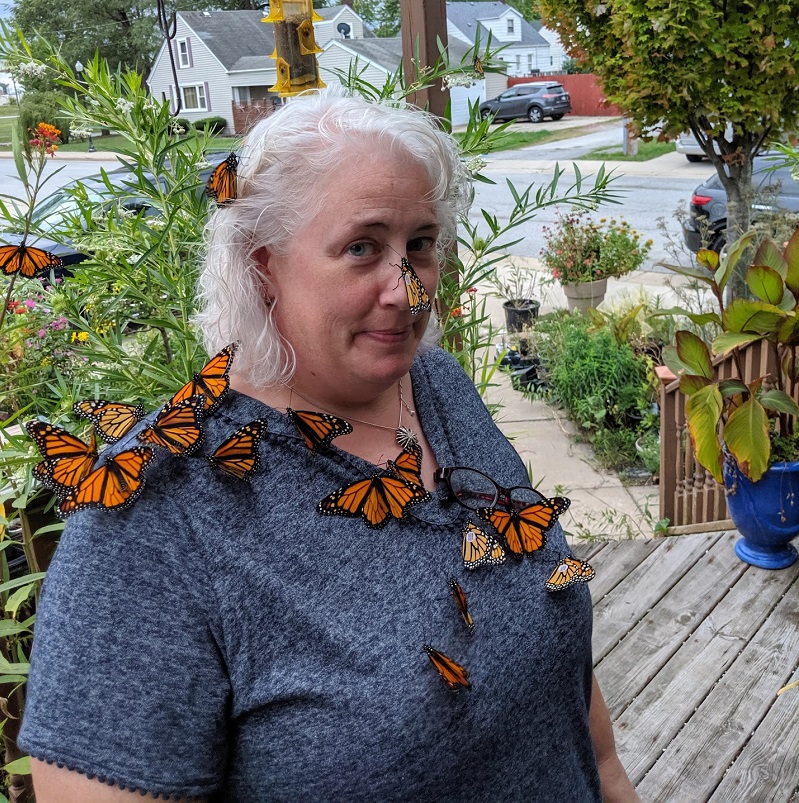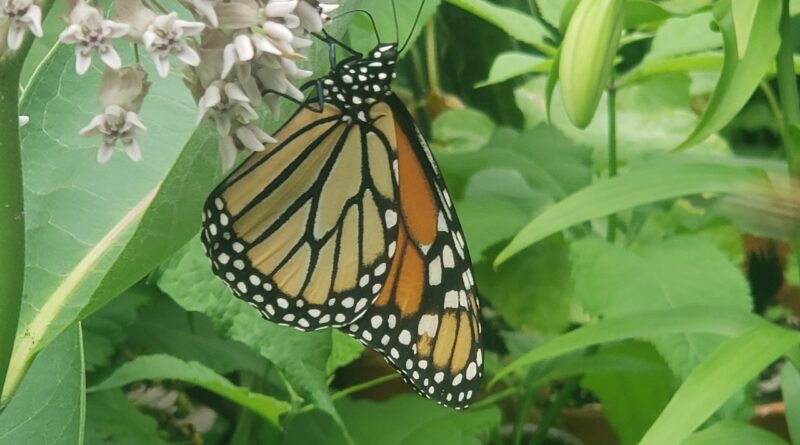Monarch Butterflies: Yet Another Species on the Brink
Podcast: Play in new window | Download (Duration: 2:07:12 — 61.2MB)
Subscribe: Apple Podcasts | Spotify | Android | iHeartRadio | Podchaser | Email | TuneIn | RSS | More
May 29, 2022) Yup. Welcome to the world we live in. Each spring, we count the number of monarch butterflies that overwintered in Mexico. We hold our collective breath and hope the numbers are good. This year, the numbers are…so-so. More monarchs flew north from Mexico than last year. But not a lot more. Oh, I know. The World Wildlife Federation (WWF) says that the population out of Mexico is up 35%. You will say, “That’s good!” However, the overwintering area has increased from 2.10 hectares (5.19 acres) in December 2020 to 2.84 hectares (7.01 acres) in December 2021. That ain’t much.
Journey North puts it in perspective.
In 2016, members of the Monarch Conservation Science Partnership published a paper that set a conservation target of 6 hectares. This population size would give monarchs a reasonable buffer against declines that often occur from one year to the next. For example, monarch numbers have declined by over 50% from one year to the next several times during the years that they have been monitored (see Graph #1). If that happened after a year with already low numbers, the population might not be able to recover. Thus, while this increase is hopeful, monarchs are still not “out of the woods”.
So, 6 hectares is the minimum target. We’re at 2.84. Monarchs are in trouble.
What’s causing the decline?
- Milkweed depletion. Milkweed along the butterflies’ migratory route in the US is essential for the species’ reproduction. It is the only plant where these butterflies lay their eggs and the only food source for monarch caterpillars.
- Illegal logging. Even though illegal logging has decreased over the years in the part of the Reserve where most of the monarchs establish their colonies, this practice has had detrimental effects, and there is still work to do for its forest to continue providing the right conditions for butterflies to overwintering.
- Climate crisis. Our warming planet is disrupting the butterflies’ migratory route between Canada, the US, and Mexico.
What do they have in common? Oh, c’mon, you know! Human beings! (Geez, do I have to explain everything?) We’re causing all of the monarchs’ problems. Not to mention untold other species on this planet. But I digress. Or not. The point is that if we cause the problems, we can solve them, too. Theoretically, anyway. In terms of monarch butterflies, we need to make sure that they’re supplied with milkweed. That’s because monarch caterpillars feed only on milkweed. However, adults utilize nectar from many different plants.
Hello, Dolly

You can help support monarch butterflies in your own backyard. That’s why horticulturist Dolly Foster is back on the show. For the past fifteen years, she was horticulturist at the Oak Lawn Park District in suburban Chicago. Now she is moving on to get her Masters degree in Crop Sciences at the University of Illinois. Her resume includes Master Gardener, Indiana accredited horticulturist and certified arborist. She also has a fascination with monarchs. And she’ll have advice about what kind of milkweed to grow in your own yard. For instance, she says there are “ramblers” like common milkweed (Asclepias syriaca) and “clumpers” like swamp milkweed (Asclepias incarnata).
Today she also talks about growing plants for other pollinators. And she’s got a bunch of them on sale at her plant sale. Don’t forget to send us your plant questions! By the way, if you’re interested in monarch butterflies, check out these sites:
Monarch Joint Venture
Monarch Watch
Journey North
World Wildlife Fund (WWF)
Save Our Monarchs Foundation
Summer Farmers Markets
Ready or not, summer is here. Memorial Day marks the beginning of the season. And that season means opening the floodgate of farmers markets. Bob Benenson from Local Food Forum reported on that just a few days ago. In addition to the dozens already open or starting this weekend, some 27 local-ish farmers markets will open between June 1st and 5th. Try not to trip over one when you’re out and about. Bob will bring us up to speed on today’s show.
But there’s more food news. On Wednesday, Secretary of Agriculture Tom Vilsack will make an announcement about shoring up the food supply chain and “transforming the food system to be fairer, more competitive, and more resilient.” Benenson writes that the Biden administration is attempting to “provide greater support for small farms and local producers across the nation, including those from historically under-represented constituencies.
Finally, he reports on World Business Chicago, the city’s public-private economic development agency. This week, it held a Future-of-Food Summit, with “emphasis on our city as the epicenter for innovation in the food and agricultural sectors.”
Lots of food issues on the table, to coin a phrase. We welcome Bob Benenson back to our show.
The Green Dispatch
We’ll try not to depress you…too much…this week.
The Annihilation of Florida: An Overlooked National Tragedy – Current Affairs
NOAA predicts as many as 6 major Atlantic hurricanes for 2022 – Axios
Weather’s unwanted guest: Nasty La Nina keeps popping up – AP News
Another ‘extremely worrisome’ climate change record set – Yahoo!News
Gas prices a much bigger factor than covid for summer travel, poll finds – The Washington Post
Carvana allowed to operate on a limited basis in Illinois – Crain’s Chicago Business
Prairie Food Co-op looks for another Lombard location after falling short of fundraising goal – Daily Herald
How to Stay Safe During Tick Season – The New York Times
Editorial: A temporary casino. Outdoor music venues by the Chicago River. Aldermen are rightly steamed. – Chicago Tribune
13-foot-long stingray found in deep hole in Mekong River – National Geographic

